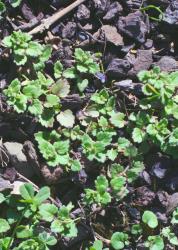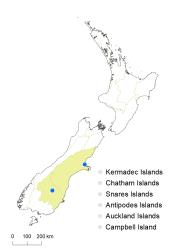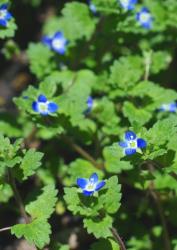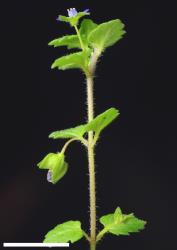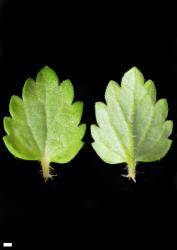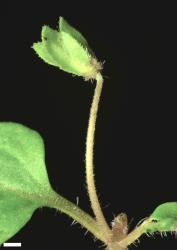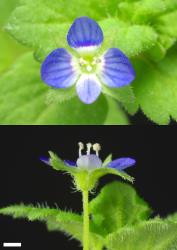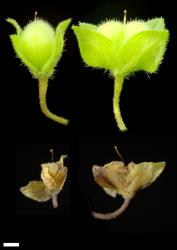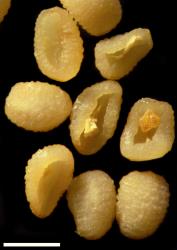Annual herb to 0.1 m tall. Stems decumbent; hairs eglandular, uniform. Leaf bud indistinct; leaves separating while very small, opposite-decussate, erecto-patent to spreading; lamina thin, lanceolate to broadly ovate, sometimes elliptic or deltoid, 4–9 mm long, 4.0–9.5 mm wide, dull to greyish-green above, paler beneath; midrib and palmate secondary veins evident; surfaces eglandular-hairy, denser beneath; margin pubescent, bluntly serrate to serrate-crenate; teeth in 2–5 pairs; apex obtuse; base abruptly cuneate to truncate; petiole 2–5 mm long. Inflorescence a terminal raceme, 50–100 mm long; flowers distant, 5–25, all bisexual; bracts alternate, leaf-like; pedicels erecto-patent to spreading, recurved beneath branches at fruiting, 3.5–10.0 mm long, shortly antrorse eglandular-hairy all around. Calyx lobes 4, acute, 1.5–3.0 mm long at flowering, 4.0–4.5 mm long at fruiting, sub-equal, shortly eglandular-hairy on and near margins and tube. Corolla 4–6 mm diameter; tube greenish-white, 0.3–0.5 mm long, < calyx, sparsely eglandular puberulent inside; lobes 4, bright blue with white base, sub-erect to spreading, sub-equal, elliptic, 1.0–1.5 mm long, rounded; nectar guides faint dark blue. Stamen filaments white, 0.7–0.8 mm long; anthers dark blue. Style glabrous, 1.0–1.5 mm long. Capsules weakly angustiseptate, emarginate, covered in short, antrorse, eglandular hairs and with straight glandular hairs along margins, 2.7–4.0 mm long, 3.5–4.0 mm at widest point. Seeds ellipsoid, smooth and deeply concave on funicle side, bluntly wrinkled and convex on back, pale brown to brown, 1.2–1.4 mm long.
V. polita plants are similar in overall appearance, growth form, and distinctive cup-shaped seeds to plants of the common V. persica and the rare V. agrestis. Plants of all three are soft, sprawling to decumbent herbs with lax terminal inflorescences and alternate leaf-like bracts. They are best distinguished by their capsules.
Capsules of V. persica are large (3.5–4.0 × 6–7 mm) with diverging lobes and a broad, v-shaped sinus between them, their faces are strongly veined when dry, their margins are strongly keeled, and they have long eglandular and a few glandular hairs in the distal half or near the margins.
Capsules of V. agrestis are similar to those of V. polita. Both have erect lobes and a narrow sinus between them, but V. agrestis capsules have a deeper sinus and are 5.5–7.0 mm wide. V. agrestis plants also differ from V. polita plants in their glandular hairs on the calyx lobe margins and a few long glandular hairs, along with the dense, short, eglandular hairs on the pedicels.
In addition, the flowers of V. polita are smaller with a bright blue corolla, whereas those of V. agrestis have a pale blue or whitish corolla, and those of V. persica are larger (8–12 mm diameter) with a blue corolla, the anterior lobe often paler.
North Island: Auckland (Auckland City: old specimens only).
South Island: Canterbury (Christchurch, especially Riccarton), Otago (Poolburn only).
A weed of gardens and arable crops. Recorded elevations range from 20 to 830 m.
Indigenous to Europe and North Africa.
Allan (1940, p. 303). Voucher: not found. There are no specimens dated before 1954 in CHR.
Flowers: July–March; fruits: September–April.
2n = 14, from overseas counts (Albach et al. 2008).
Veronica polita is classified in V. subg. Pocilla (Albach et al. 2004; Albach & Meudt 2010).
One additional specimen is identified as V. aff. polita. It matches V. polita, except the capsule is glabrous and the leaves only sparsely hairy (CHR 83295, Upper Riccarton, Healy, 15 Nov 1954).



